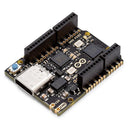Arduino UNO Mini Limited Edition
by Arduino






The Arduino UNO Mini Limited Edition is a collector’s item for serious Arduino lovers. It’s a miniaturized but fully functioning version of the well-known Arduino UNO, in a special livery and packaging.
The world's favorite development board has gone mini. Everything in this version of the Arduino UNO is unique. Black and gold, finishing, elegant design and packaging, all delivered to the highest standard. A little jewel to celebrate the Arduino community and what we’ve been doing together for all these years.
Each item is unique and numbered on the PCB, and includes a hand-signed letter from the founders. It’s a limited edition, so get while it’s in stock!
For serious Arduino UNO lovers
Arduino UNO Mini Limited Edition is a collector’s item for serious Arduino Lovers: hobbyists, students, makers, reimaginers, dreamers, hopers, fans, engineers, designers, questioners, cake-makers, problem-solvers, puzzlers, gamers, debaters, developers, entrepreneurs, architects, future-shapers, musicians, scientists... 10 million projects based on (official) Uno boards that have contributed to this incredible story.
Numero UNO in the Maker Space
“Uno” means one in Italian and was chosen in 2010 to mark the release of the Arduino IDE 1.0 software, five years after the Arduino project was born.
With over 10 million official UNO boards running amazing projects around the world, the Arduino UNO has been the number one choice for makers for over a decade.
This limited edition celebrates our most iconic board, and all of the amazing projects that our community has created over the years. The UNO Mini LE functions exactly as the classic UNO, so it can very easily be used in any UNO projects.
Getting Started
The Getting Started section contains all the information you need to configure your board, use the Arduino Software (IDE), and start tinkering with coding and electronics.
Technical Specifications
The Arduino UNO Mini LE is a microcontroller board based on the ATmega328P (datasheet). It has 14 digital inputs/outputs (six of which can be used as PWM outputs), six analog inputs, a 16MHz ceramic resonator, a USB-C connector, and a reset button. Contains everything needed to support the microcontroller. Simply connect it to a computer with a USB cable, use a power adapter, or connect a battery to get started.
| Microcontroller | ATmega328P |
| USB connector | USB-C |
| Built-in LED Pin | 13 |
| Digital I/O Pins | 14 |
| Analog input pins | 6 |
| PWM pins | 6 |
| UART | yes |
| I2C | yes |
| SPI | yes |
| Circuit operating voltage | 5V |
| Input voltage (limit) | 6-12V |
| Battery connector | None. |
| DC Current per I/O Pin | 20 mA |
| DC Current for 3.3V Pin | 50 mA |
| Main Processor | ATmega328P 16 MHz |
| USB-Serial Processor | ATmega16U2 16 MHz |
| Memory ATmega328P | 2KB SRAM, 32KB FLASH, 1KB EEPROM |
| Weight | 8.05 g |
| Width | 26.70 mm |
| Length | 34.20 mm |
Documentation
This board is open-source hardware, get the sources here.
Last chance to buy
It's sad to say goodbye but sometimes we have to retire products to make way for new things - grab it while you can!
-
Arduino UNO Mini Limited Edition
ABX00062£43.75
Shop with confidence – we've been serving the hobbyist electronics, Maker, and retro gaming communities since 2012.
- Satisfaction or refund guarantee
- Worldwide shipping via mail or courier
- 57,000+ customer reviews
- Secure website and payments
